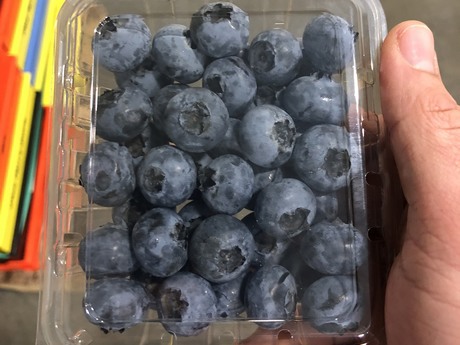Domestic blueberry production is kicking off what’s anticipated to be a solid season.
“We began last week out of Florida and it’s really good product,” says Luciano Fiszman of Redondo Beach, Ca.-based Gourmet Trading Co. Peak Florida production will likely go between April 8-25, which is when Mexico’s production should begin to fade.
Also in the southeast, Georgia may have a bigger crop this year. “Georgia was hit for two consecutive years with freezing. They had a cold snap in March. But this year, the chance of a late freeze is gone and the plants, which have the energy of three years from not producing fruit, are ready,” says Fiszman.
However a cold front and some spotty rains this week did set back production in both states. Until then, it was anticipated the regions would begin seven to 10 days earlier but now the southeast will begin production at its regularly anticipated time.
 Gourmet Trading's Super Blues are packed in Florida and headed to Hong Kong.
Gourmet Trading's Super Blues are packed in Florida and headed to Hong Kong.
California production
On the West Coast, California is also starting up stronger regional production. “We’re expecting California to produce fruit by the end of April and to go throughout May,” says Fiszman, noting that Gourmet Trading does have a blueberry farm south of the San Joaquin Valley, as well as farms in Peru and New Zealand.
While California is known for strawberries, its conditions that differ from the southeast make for a sweet product. “The dry conditions compared to the wet conditions in the southeast, the genetics, it’s big fruit with good bloom and firm. The difference in temperature between night and day means there's more sugar on the fruit,” says Fiszman. He adds that while there’s coastal production under hoops currently happening, it’s higher priced because it’s difficult to produce. The late April production will come from California’s San Joaquin Valley.
Import picture
Meanwhile on imports, Mexico is currently in peak production with blueberries. “There are a few regions that are slowly getting behind their peak. I’m expecting Mexican peak will last another two weeks,” says Fiszman. “So right after week 14, the first week in April, Mexico will start slow their crossings.” Overall, Mexico’s production is strongest between Valentine’s Day and mid-April.
This finishes up a stronger year production-wise for the country. “Mexico had roughly 15 percent more volume because they had more acreage, perfect weather conditions and more mature plantings,” says Fiszman. “The growers are also learning more and more how to do the business. It’s a maturing industry.”
However, that extra 15 percent made up for an early finish on imports from Chile due to weather.
Demand looking better
Demand for blueberries is also picking up again now that better quality product is making its way in. “We had a good winter season but with the late Chilean berries, the quality dropped. And then consumers weren’t satisfied with what they purchased,” says Fiszman. “So in late February and the first few weeks in March, demand was low. Now demand is picking up again. Blueberries are really an item driven more by quality than price.”
As for price, this switchover is making for a two-tier blueberry market right now. “You can get cheap blueberries but you get what you pay for. And then there’s more expensive product that you enjoy more from Mexico and Florida,” says Fiszman.
He notes that the two-tier has only been like this for the past 10 days and will likely only last another five days. “This happens twice a year when there’s a transition. So now when it’s moving from into Mexico/Florida and August/September when you come out of the local deal vs. a fresh crop.”
It’s anticipated the market will more into more promotable volumes and price from mid to late April.
For more information:
Luciano Fiszman
Gourmet Trading Co.
Tel: +1 |(310) 216 7575 ext 1888
[email protected]
http://gourmettrading.net/










